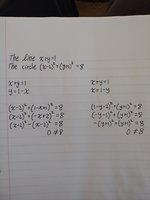Intersection of a Line and Circle
- Thread starter Anthobet
- Start date
Dr.Peterson
Elite Member
- Joined
- Nov 12, 2017
- Messages
- 16,814
First, (-x + 2)^2 is not the same as -(x - 2)^2. Do you see why?
(Hints: Can a positive number equal a negative number? Can you pull a factor out from inside a square without squaring the factor?)
Second, if you did get 0 = 8, that would just mean there is no solution, which is a valid answer to have (apart from not being among the choices). Luckily, that won't happen when you fix the work.
(Hints: Can a positive number equal a negative number? Can you pull a factor out from inside a square without squaring the factor?)
Second, if you did get 0 = 8, that would just mean there is no solution, which is a valid answer to have (apart from not being among the choices). Luckily, that won't happen when you fix the work.
First, (-x + 2)^2 is not the same as -(x - 2)^2. Do you see why?
(Hints: Can a positive number equal a negative number? Can you pull a factor out from inside a square without squaring the factor?)
Second, if you did get 0 = 8, that would just mean there is no solution, which is a valid answer to have (apart from not being among the choices). Luckily, that won't happen when you fix the work.
Ohh I see. I factored it incorrectly. If I'm going to factor like that, it should be ( -x + 2)2 = (-( x - 2 ))2 which I don't see any use for. So I just foiled and got my answer. Thank you so much ?
pka
Elite Member
- Joined
- Jan 29, 2005
- Messages
- 11,988
\(\displaystyle \begin{align*}8&=(x-2)^2+(y+1)^2 \\&=(x-2)^2+(1-x+1)^2\\&=(x-2)^2+(2-x)^2\\&=(x^2-4x+4)+(4-4x+x^2)\\&=2x^2-8x+8\\4&=x^2-4x+4\\0&=x(x-4)\\x&=4,~0 \end{align*}\)
Dr.Peterson
Elite Member
- Joined
- Nov 12, 2017
- Messages
- 16,814
There is great use for it if you continue! Just distribute the square over the product:Ohh I see. I factored it incorrectly. If I'm going to factor like that, it should be (-x + 2)2 = (-( x - 2 ))2 which I don't see any use for. So I just foiled and got my answer. Thank you so much ?
[MATH](-x + 2)^2 = (-1(x - 2))^2 = (-1)^2(x-2)^2 = (x-2)^2[/MATH]
so the equation becomes [MATH](x-2)^2 + (x-2)^2 = 8[/MATH]. From there, you end up with [MATH](x-2)^2 = 4[/MATH], and so on.
(Or you could do what pka did, which may be what you did already.)


